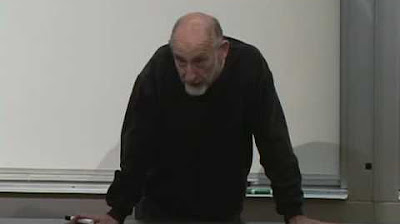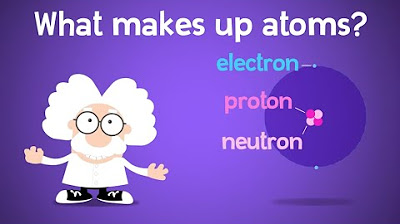Why Don't Protons Fly Apart in the Nucleus of Atoms? RESIDUAL Strong Force Explained
TLDRThe video explores the fundamental forces in nature, emphasizing the strong nuclear force that binds protons and neutrons in atomic nuclei. It explains how quarks and gluons, carrying color charges, interact through constant gluon exchange, forming a flux tube that keeps quarks confined. The strong nuclear force, a residual effect of this interaction mediated by mesons, is crucial for binding protons and neutrons, enabling the existence of heavier atoms and life itself. The video also introduces courses on Brilliant.org to deepen understanding of quantum mechanics and scientific thinking.
Takeaways
- 🌌 There are four fundamental forces in nature: gravity, weak force, electromagnetism, and the strong nuclear force.
- 🔝 Electromagnetism is 10^37 times stronger than gravity and is responsible for atomic structure.
- 🔨 The strong nuclear force is the strongest force at the atomic nucleus scale and counteracts the repulsive force of electromagnetism.
- 🔄 Quantum chromodynamics explains the strong force and the interactions between quarks and gluons within protons and neutrons.
- ⚫️ Quarks carry a 'color charge' and are bound together by gluons, which mediate the strong force through constant exchange.
- 🔗 The constant gluon exchange creates a 'flux tube' between quarks, which is analogous to a rubber band keeping quarks confined.
- 💥 The strong force gets stronger as quarks are pulled apart, unlike electromagnetism and gravity which weaken with distance.
- 🐦 Mesons are formed when quark-antiquark pairs are created at the breaking point of the 'rubber band', and mediate the residual strong force.
- 🔴 The strong nuclear force, a residual of the strong force, is responsible for binding protons and neutrons in atomic nuclei.
- 🌟 The strong nuclear force is effective only at very short distances and diminishes rapidly, limiting the size of atomic nuclei.
- 🎓 Brilliant.org offers courses like Quantum Mechanics and Scientific Thinking for those interested in learning more about fundamental physics concepts.
Q & A
What are the four fundamental forces in nature?
-The four fundamental forces in nature are gravity, the weak force, electromagnetism, and the strong force.
How does electromagnetism compare in strength to gravity?
-Electromagnetism is approximately 10^37 times stronger than gravity.
What prevents protons in an atom's nucleus from repelling each other apart?
-Protons in an atom's nucleus are kept together by the strong nuclear force, which is much stronger than the electromagnetic force that would otherwise repel them.
What is quantum chromodynamics and what does it describe?
-Quantum chromodynamics is a theory in particle physics that describes the strong force between quarks and gluons, which are the fundamental particles that make up protons and neutrons.
What are quarks and gluons, and how do they relate to the strong force?
-Quarks are fundamental matter particles found in protons and neutrons, while gluons are force particles that mediate the strong force between quarks. Gluons bind quarks together, creating the strong nuclear force.
What is the role of color charge in quantum chromodynamics?
-Color charge is a property of quarks and gluons that is analogous to electric charge but works through a different mechanism. It is responsible for the strong force that binds quarks together within protons and neutrons.
How does the strong force differ from electromagnetism in terms of distance?
-Unlike electromagnetism and gravity, which weaken with distance, the strong force gets stronger as quarks are pulled apart. However, if quarks are separated too far, the force diminishes rapidly.
What is confinement in quantum chromodynamics?
-Confinement in quantum chromodynamics is the principle that quarks cannot exist freely; they are always confined within composite particles like protons and neutrons due to the strong force.
What are mesons and how do they contribute to the strong nuclear force?
-Mesons are particles composed of a quark and an antiquark pair. They are formed when the strong force 'rubber band' breaks between quarks. Mesons mediate the residual strong force, or strong nuclear force, that binds protons and neutrons together in atomic nuclei.
How does the strong nuclear force limit the size of atoms?
-The strong nuclear force is effective only at very short distances, on the order of a proton's diameter. Beyond this distance, the force diminishes, which limits the size of atomic nuclei and thus the size of atoms.
What are the courses recommended for those interested in learning more about fundamental physics?
-For those interested in learning more about fundamental physics, the video recommends 'Quantum Mechanics with Sabine' and 'Scientific Thinking' courses available on Brilliant.org.
Outlines
🔬 Introduction to the Four Fundamental Forces and the Strong Nuclear Force
This paragraph introduces the concept of the four fundamental forces in nature, emphasizing the dominance of electromagnetism over gravity at the quantum scale. It explains the strong nuclear force, which is a hundred times stronger than electromagnetism, and is responsible for holding protons and neutrons together in the nucleus of atoms against the repulsive electromagnetic force. The video aims to provide insight into quantum chromodynamics and the mechanisms that keep protons and neutrons bound together within the atomic nucleus.
🌀 The Role of Quarks, Gluons, and Color Charge in the Strong Force
The second paragraph delves into the composition of protons and neutrons, explaining that they are made up of quarks and gluons. It introduces the concept of color charge, which is analogous to electric charge but operates through a different mechanism. The paragraph describes how gluons, carrying color charge, bind quarks together by exchanging color charge continuously, creating a flux tube between them. It also touches on the concept of confinement in quantum chromodynamics, which states that quarks cannot exist freely but are always confined with at least one other quark.
💥 The Residual Strong Force and Mesons in Nuclear Binding
This paragraph explains the residual strong force, which is responsible for binding protons and neutrons together in the nucleus of atoms. It describes how the strong force works differently from electromagnetism, getting stronger as quarks are pulled apart, akin to a rubber band. The paragraph introduces mesons, which are quark-antiquark pairs formed when the energy required to break the 'rubber band' creates new quarks and antiquarks. It also explains how mesons mediate the residual strong force between nucleons, which is essential for the existence of atoms heavier than hydrogen and, consequently, for life as we know it.
📚 Understanding Quantum Chromodynamics and Feynman Diagrams
The final paragraph discusses the complexity of quantum chromodynamics and how Richard Feynman's Feynman diagrams provide a visual and intuitive way to represent the interactions between particles. It explains the process of color charge exchange between quarks through the emission and absorption of gluons, which is essential for keeping quarks confined within nucleons. The paragraph then describes a more complex Feynman diagram that illustrates the interaction between a proton and a neutron via the exchange of mesons, highlighting the role of mesons in mediating the strong nuclear force that keeps protons and neutrons bound together in the nucleus.
🎓 Resources for Learning Physics and Quantum Mechanics
In the closing paragraph, the speaker recommends courses on Brilliant.org for those interested in learning more about physics and quantum mechanics. The speaker mentions a new course on Quantum Mechanics with Sabine Hossenfelder, which covers the fundamentals of quantum mechanics through interactive quizzes. Additionally, the speaker suggests Brilliant's Scientific Thinking course for those looking to understand essential scientific principles without being overwhelmed by math. The speaker also provides a special offer for viewers, encouraging them to sign up for free and support the channel.
Mindmap
Keywords
💡Fundamental Forces
💡Quantum Chromodynamics
💡Color Charge
💡Confinement
💡Meson
💡Feynman Diagrams
💡Strong Nuclear Force
💡Quarks
💡Gluons
💡Binding Energy
Highlights
There are four fundamental forces in nature: Gravity, weak force, electromagnetism, and the strong force.
Gravity is dominant at macroscopic scales, while the other three forces dominate at the quantum scale.
Electromagnetism is 10^37 times stronger than gravity and keeps electrons near protons in atoms.
The strong nuclear force is a hundred times stronger than electromagnetism and binds protons and neutrons in atomic nuclei.
Quantum chromodynamics (QCD) provides insight into the interactions between protons, neutrons, and the strong force.
Protons and neutrons are made of quarks and gluons, which carry a color charge and are the fundamental particles of the strong force.
Color charge is analogous to electric charge but operates through a different mechanism and has nothing to do with optical colors.
Gluons bind quarks together by constantly exchanging color charge, creating a flux tube between them.
The strong force gets stronger as quarks get farther apart, unlike electromagnetism and gravity, which weaken with distance.
Quarks cannot exist alone; they are always confined with at least one other quark due to confinement in QCD.
The energy required to separate quarks beyond a certain point creates a new quark-antiquark pair, called a meson.
Mesons mediate the residual strong force, or strong nuclear force, that binds protons and neutrons together in atomic nuclei.
The strong nuclear force is a residual force caused by the not-quite-perfect neutrality of color charges within nucleons.
The strong nuclear force is effective only at very short distances, on the order of the diameter of a proton.
The strong nuclear force limits the size of atoms, as nuclei beyond a certain size are not stable.
Brilliant.org offers courses like Quantum Mechanics and Scientific Thinking for those interested in learning more about fundamental concepts in physics.
The strong force and the strong nuclear force are distinct, with the latter being a residual force that keeps protons and neutrons bound together.
Transcripts
5.0 / 5 (0 votes)
Thanks for rating:





